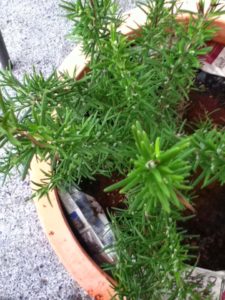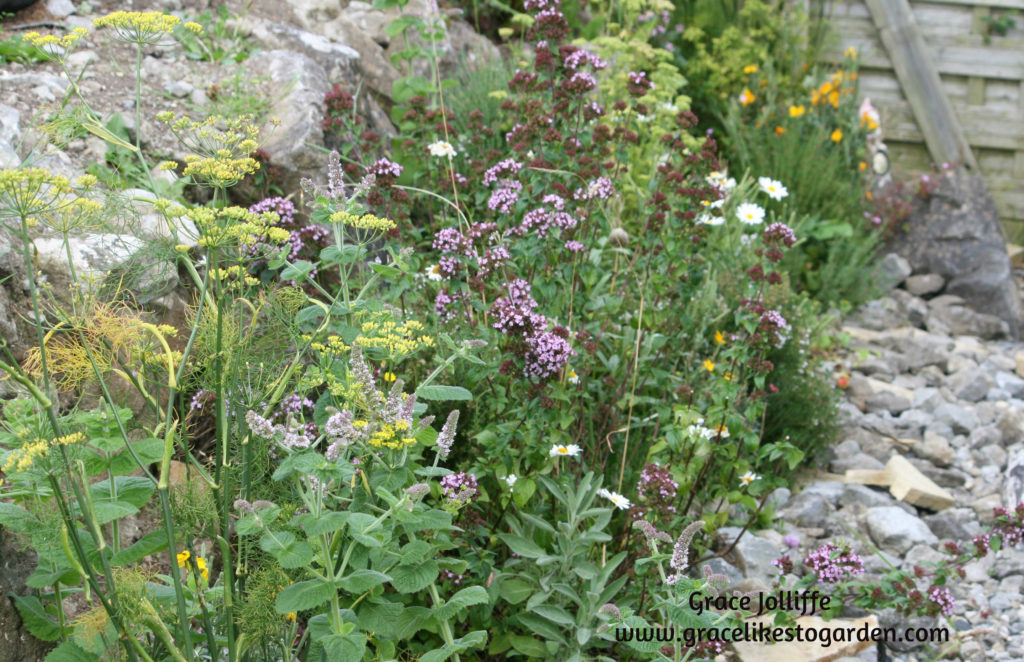 Growing herbs is one of the easiest and most rewarding things you can do in your garden.
Growing herbs is one of the easiest and most rewarding things you can do in your garden.
No matter how small your garden is you can grow herbs.
Herbs can be grown on the smallest of balconies, or you can even grow them in pots on your window ledges.
They are easy to grow and the benefits of herbs are endless.
Herbs can be used to make teas, infusions, herbal remedies and are a tasty addition to soups and casseroles. In fact most dishes you can think of use at least one herb.
HOW DO YOU LIKE YOUR HERBS?
Home grown herbs smell fresher and taste better than shop bought ones.
Growing your own is a great way of ensuring that your herbs are free from unwanted additives and chemicals.
It is also a lot cheaper.
Growing your own food, even just herbs puts you in touch with the process of growing and is a great first step into growing your own vegetables.
 Many gardeners, myself included, started out by simply planting just a few herbs and were encouraged by their success to go on and plant fruit and vegetables.
Many gardeners, myself included, started out by simply planting just a few herbs and were encouraged by their success to go on and plant fruit and vegetables.
I started off with parsley and can remember snipping off my first leaves to add to a white sauce.
The pleasure I got from knowing that I had grown at least one ingredient for my dish inspired me to plant more.
I began to experiment with growing rosemary (my favourite), thyme, marjoram, oregano, chives, sage, basil, fennel and several varieties of mint.
I have grown all these plants from seeds started off in my small greenhouse but before I got the greenhouse I used my window ledges.
As long as you don’t mind your windows being cluttered with trays of compost this works perfectly well.
BUYING SEEDS
I am a member of Irish Seedsavers which is a wonderful organization based in nearby County Clare, here in Ireland.
They guard and save heritage seeds that would otherwise be extinct.
They also have great organic gardens which are open to the public on certain days of the year and these are well worth a visit.
I receive five packets of organic seeds a year from Irish Seedsavers as part of my membership and I also buy seeds and other garden essentials from them.
They do an excellent mail order service.
Buying from them and other similar organizations supports the work they do.
Sadly we are now in a situation where huge multinational seed manufacturers are rushing around buying up seed patents.
Irish Seedsavers and organizations like them are ensuring that we continue to have a wide variety of seeds into the future.
WHY SAVE SEEDS?
This reduction in available seeds is something we all need to think about – if we want a wide variety of healthy seeds and foods for our children and grandchildren.
I am now saving my own seeds, so there is always something growing in my greenhouse.
However, you don’t need a green house, you can grow from seed on a sunny window ledge, like I used to do. Or you can buy the plants from the garden centre.
WHAT’S IN YOUR CUPBOARDS?
But, before you go buying your seeds or plants I would advise you to look in your own kitchen cupboards and think about the herbs you buy most of because they’re the ones you need to plant.
Exotic herbs are great and if you have the space in your garden then go ahead and plant them.
But if you only have a tiny garden, or balcony and you know you won’t actually use what you grow, my advice would be to start with the basics – you can always add more later.
GROWING FROM SEED
If you are planning on having a large number of herbs and if your budget is small I would advise starting from seed. Plants are expensive especially if you are buying in quantity.
It is only 2-3 euro for a packet of seeds and a packet goes a long way. You can swap seeds with friends and save the ones you didn’t use for next year.
I have found no problem with keeping leftover seeds and planting them the following year. They grew just the same.
If you are growing from seeds you can use small pots, specially designed seed trays, or like me you can just use those plastic trays that mushrooms come in – there is enough plastic in the world.
I wish the shops would stop using the plastic containers. I usually buy from local growers to avoid them, but not everything we use grows locally so inevitably some of these trays find their way into the house.
SOWING YOUR SEEDS
Fill your trays or pots with compost and gently tip the seed packet into your hand – pouring out as few as you possibly can.
The seeds are tiny and you don’t need to sow many of them.
Some people just gather a few under their fingernails and then pick them out.
I can’t do this as my nails are too short. If you like you can use a tweezers although this is fiddly.
If you are using a mushroom tray then I would scatter 8-10 seeds. If you have a proper seed tray then try and place just 1-2 seeds in each individual compartment or cell.
Push the seeds gently into the soil – they only need to be 2-3 times the size of the seed deep, so don’t push too far!
Water the seeds gently and place in a warm area.
Some gardeners use cling film to cover the pots or trays, but I find it doesn’t cling to my mushroom trays so I don’t bother. But some growers find it helpful as it keeps the soil damp without watering.
GENTLY DOES IT
It is important to keep the soil damp and the only time I have had seed failures is when I forgot to do this.
The best thing to use is a spray bottle and spray gently!
In fact ‘gently’ is the key to all things seed, especially when your seedlings have formed.
Once they have grown two true leaves, or are about 2 inches tall they are ready for potting on in larger pots.
To do this water them and let them drain.
Loosen the root-ball from below and lift by the leaves – not the stems or this can damage the delicate plant.
Again do this gently.
HARDENING OFF
If you are going to plant them outside you should start leaving them outside for a few hours per day.
Leaving them outside like this gets them used to being outdoors and is generally referred to as hardening them off.
CHOOSE WISELY
If you are planting outside think carefully about where you will position your herbs. You may not want them in your raised beds if your space is limited.
 HOW DO YOU ACCESS YOUR HERBS?
HOW DO YOU ACCESS YOUR HERBS?
You also need to think about access.
If you plan on growing herbs to use in cooking, or in making herbal teas then you want them near the kitchen.
Access is important. You don’t want to be running over wet grass to the bottom of the garden if it’s raining.
As you can see in the above picture, I have a little path near my kitchen where I grow a selection of the herbs I use most.
Borders are great as not only are the herbs easy to reach but they give you a pretty and fragrant edge.
Think about the space and light your herbs need. The back of the packet will tell you all you need to know so you can plan.
BE CAREFUL
If you are planting something like mint then be careful where you plant it.
Mint spreads and you may want to keep it confined to pots if space is an issue.
Growing herbs can transform your garden or balcony and if you have space don’t forget to experiment.
Keep note of what works and what doesn’t and as your knowledge and experience grow so will the rewards.
Best of luck with growing herbs and do let me know how you get on in the comments box below. I’d love to hear from you.
Happy Gardening
Grace









Recent Comments